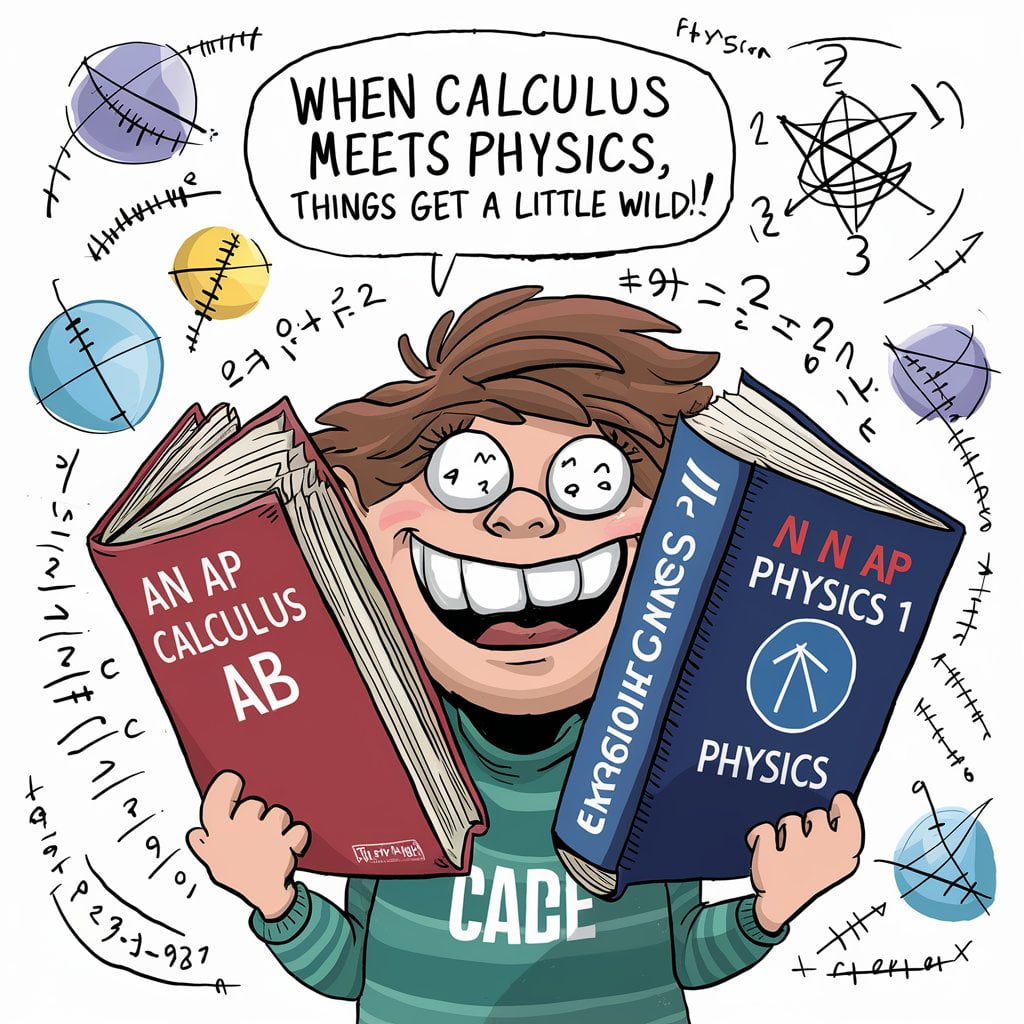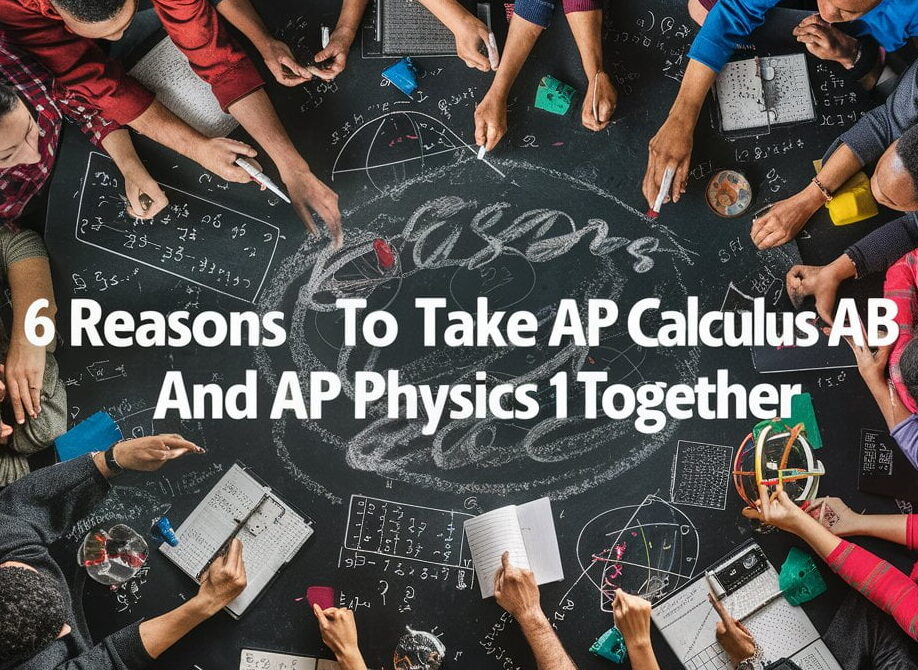Introduction
Choosing the right combination of Advanced Placement AP courses can have a profound impact on a student’s academic journey, especially for those with a passion for science, technology, engineering, or mathematics (STEM). Among the many AP course options, AP Calculus AB and AP Physics 1 stand out as a powerful pair. Both courses, while challenging on their own, complement each other in ways that make learning more cohesive and meaningful.
In AP Calculus AB, students inspect deep into the fundamental concepts of calculus, learning to analyze change and motion through derivatives, integrals, and limits. Meanwhile, AP Physics 1 focuses on understanding the natural world by applying these very mathematical principles to topics like mechanics, energy, and SHM. Taking both courses together offers an enriching experience where mathematics meets the physical world, creating a holistic learning environment that not only boosts academic performance but also enhances problem-solving and critical thinking skills. For students eager to challenge themselves, combining these two courses is an excellent preparation for some of the most difficult AP exams.
This blog outlines 6 compelling reasons why students should consider taking AP Calculus AB and AP Physics 1 together. From reinforcing concepts across subjects to preparing for STEM majors, the combination provides a unique opportunity to make the most of your high school education.
1. Building a Strong Foundation in Problem Solving
One of the key benefits of taking AP Calculus AB and AP Physics 1 together is the significant improvement in problem-solving abilities. While these two subjects may seem distinct, they are both deeply connected through their emphasis on critical thinking and analytical reasoning. Both courses focus on solving problems, but each offers a unique perspective, creating a complementary learning experience.
In AP Calculus AB, students tackle mathematical problems using tools like derivatives and integrals, focusing on the rate of change and accumulation. These skills are crucial for understanding how things change over time, making them highly valuable when analyzing real-world problems. On the other hand, AP Physics 1, though algebra-based, applies similar problem-solving strategies to physical situations. In this course, students explore the behavior of objects, understanding how forces interact, how motion works, and how energy is transferred or conserved—without needing calculus.
By studying both courses simultaneously, students develop a well-rounded approach to problem-solving. In calculus, problems tend to be more abstract, dealing with mathematical relationships, while in physics, those abstract concepts are applied to real-world situations. For example, AP Calculus AB might present a problem involving the rate of change in an object’s velocity (acceleration), while AP Physics 1 shows how this concept applies to practical scenarios like the motion of a car or a falling object. This interplay between abstract mathematics and real-world physics enriches a student’s ability to think analytically from multiple angles.
Moreover, both subjects require logical thinking and a systematic approach. In AP Physics 1, students are often required to break down physical scenarios step-by-step, using algebra to solve for forces, motion, and energy interactions. This method is similar to how calculus problems require breaking down complex functions into simpler parts. Developing this skill set across both subjects not only enhances academic performance but also sharpens critical thinking and decision-making abilities in everyday life.
2. Developing Versatility in Approaching Real-World Problems
Taking AP Calculus AB and AP Physics 1 together helps students develop versatility in their problem-solving approaches, especially for real-world challenges. Both courses present different types of problems—abstract mathematical ones in calculus and physical, tangible ones in physics—but they ultimately teach students how to think critically and adapt their methods based on the situation.
For instance, physics problems often involve analyzing forces and motion using algebra, while calculus deals with rates of change and accumulation. By learning to approach both types of problems, students become flexible thinkers who can tackle issues from multiple angles. This versatility is invaluable not only in academics but also in fields like engineering, data science, and economics, where complex systems often require multidisciplinary solutions.
By mastering both algebra-based and calculus-based thinking simultaneously, students gain confidence in their ability to solve a wide variety of problems, better preparing them for real-life challenges in their future careers.
3. A Deeper Understanding of Physics
Taking AP Calculus AB alongside AP Physics 1 can significantly enhance a student’s grasp of physics, even though AP Physics 1 is algebra-based. Physics is all about explaining how the world operates through mathematical models, and while calculus can provide deeper insights, AP Physics 1 is specifically designed to make these concepts approachable using only algebra. However, studying calculus at the same time can help students better appreciate the foundations behind the algebraic methods used in physics.
For example, key topics in AP Physics 1 such as kinematics, forces, and energy are well-covered with algebra, but a concurrent study of calculus can provide a more complete perspective. While AP Physics 1 defines acceleration as the change in velocity over time, calculus explains it as a derivative of position with respect to time. By understanding these calculus-based concepts, students don’t just rely on memorized formulas—they gain an appreciation for the reasoning behind those formulas, even if they don’t use calculus directly in AP Physics 1.
Newton’s Second Law of Motion (F = ma) is an example where students can benefit from this broader understanding. In an algebra-based context, acceleration is simply the change in velocity, but calculus reveals it as the derivative of velocity over time, which, in turn, is derived from the change in position. While AP Physics 1 doesn’t require this level of calculus, knowing the relationship between position, velocity, and acceleration can offer students a deeper understanding of the nature of motion.
Additionally, concepts like work and energy are handled in AP Physics 1 using algebra, but in advanced physics, these topics are closely related to integrals in calculus. Work, for instance, involves integrating force over a distance, which calculus helps to explain. Even though students won’t need to calculate integrals in AP Physics 1, learning how to do so in AP Calculus AB can offer more confidence when tackling similar problems in future physics courses.
Lastly, calculus sheds light on how physical systems evolve over time, which is central to phenomena like oscillations and waves. While AP Physics 1 simplifies these ideas using algebra, a background in calculus can give students a preview of more advanced topics they’ll encounter later, such as differential equations, which describe how systems change. Even without using calculus directly, a solid understanding of the principles behind algebraic models in physics can make complex topics more approachable. In AP Physics 1, having a solid understanding of the equation sheet essentials will make complex problems more approachable.
4. Boosting College Admissions Prospects
Taking both AP Calculus AB and AP Physics 1 together not only enhances academic knowledge but also strengthens a student’s college application, making it stand out in a competitive admissions landscape. These courses are widely recognized as challenging, rigorous, and integral to building a strong foundation in STEM. Successfully managing both simultaneously signals to admissions officers that a student is not only academically capable but also willing to push boundaries and tackle complex subjects head-on.
Many colleges, especially those with strong STEM programs, look for applicants who have demonstrated readiness for advanced coursework. By enrolling in both AP Calculus AB and AP Physics 1, students show that they are prepared for the demands of college-level courses. These subjects are often prerequisites for STEM majors, including engineering, physics, mathematics, and computer science, and completing them in high school provides students with a significant head start.
Moreover, AP courses carry more weight in the admissions process than standard high school courses because they are designed to simulate the rigor of college classes. Taking two AP courses that are mathematically and conceptually linked shows initiative and a clear commitment to mastering difficult material. This level of academic maturity reflects positively in application essays, letters of recommendation, and interviews.
Beyond just impressing college admissions officers, excelling in both AP Calculus AB and AP Physics 1 can also lead to college credit or advanced placement in university. Many colleges offer credit for high AP exam scores, allowing students to skip introductory courses in college and move directly into more advanced topics. This can provide students with greater flexibility in their course schedules, enabling them to explore more electives, double majors, or even early graduation.
Additionally, understanding how AP exams translate into college credits can help students maximize the benefits of taking these courses simultaneously. Balancing two demanding AP subjects at once shows that a student is capable of handling challenging workloads, which is a key concern for college admissions committees.

5. Preparation for STEM Majors
For students planning to pursue a career in STEM (Science, Technology, Engineering, and Mathematics), taking AP Calculus AB and AP Physics 1 together is a critical step in building a strong academic foundation. These two subjects are not just beneficial but essential for understanding advanced concepts in fields such as engineering, physics, computer science, and even certain areas of biology and chemistry.
In most STEM majors, calculus and physics form the core of early coursework. Engineering students, for example, will regularly encounter topics that require a deep understanding of calculus to analyze forces, motion, energy, and more. Whether it’s designing bridges, optimizing engines, or working with electrical circuits, engineers need to apply both the principles of physics and the mathematical tools of calculus. Taking STEM oriented AP Programs including these two AP courses in high school provides a solid head start and helps students feel more confident when they transition into college-level STEM programs.
Similarly, physics majors will constantly rely on calculus to make sense of the natural world. Advanced topics such as electromagnetism, quantum mechanics, and fluid dynamics all depend heavily on mathematical models built from calculus. By taking AP Physics 1 and AP Calculus AB together, students begin to develop the analytical skills necessary to excel in these complex areas of study.
Even computer science students, who may not initially think of physics as relevant to their major, will benefit from this pairing. Many computer science applications, such as algorithms, machine learning, and data science, involve calculus concepts like optimization and rate of change. Additionally, areas like graphics programming and simulation (used in video games, animations, and virtual reality) require an understanding of both physics and calculus to create realistic models and movements.
The benefit extends to biological sciences as well. Fields like bioengineering, biophysics, and even advanced medical research require a solid grasp of both subjects. For example, biomechanics (the study of movement in biological systems) uses physics to understand forces and motion, while calculus is used to model biological systems and predict outcomes.
Furthermore, taking these courses in high school gives students a competitive advantage when applying for STEM-related internships, scholarships, and summer programs. Many of these opportunities look for students who have not only shown interest in STEM but have also demonstrated competence in these foundational subjects. It sets the stage for students to pursue cutting-edge research and innovation as early as possible.
6. Strengthening Interdisciplinary Connections
One of the most enriching aspects of taking AP Calculus AB and AP Physics 1 together is the opportunity to strengthen interdisciplinary connections. These courses, while distinct in their focus, are deeply interconnected, and studying them concurrently allows students to see how different fields of knowledge intersect and complement each other. This interdisciplinary approach fosters a more integrated understanding of both subjects and prepares students to tackle complex, multifaceted problems.
In AP Calculus AB, students learn about mathematical concepts such as limits, derivatives, and integrals. These concepts are abstract and theoretical, providing a foundation for understanding various mathematical phenomena. On the other hand, AP Physics 1 applies these mathematical tools to real-world physical scenarios, such as analyzing the motion of objects, understanding forces, and studying energy transfer.
By studying these subjects together, students can see how calculus concepts are used to solve physical problems. For instance, understanding how to calculate the area under a curve (using integrals) is crucial for solving problems related to displacement and work in physics. Similarly, learning about the rate of change of functions (derivatives) helps in understanding concepts such as velocity and acceleration.
This integration of knowledge fosters a holistic understanding of how mathematical and physical principles work together. Students can appreciate how abstract mathematical theories are not just theoretical exercises but practical tools for understanding and solving real-world problems. This perspective can make learning more engaging and meaningful, as students see the relevance of their studies beyond the confines of each individual course.
Additionally, this interdisciplinary approach enhances critical thinking and problem-solving skills. When faced with complex problems that involve both calculus and physics, students must draw upon their knowledge from both subjects to find solutions. This experience helps them develop the ability to approach problems from multiple angles and integrate different types of knowledge, a valuable skill in many fields and real-life situations.
For students considering future studies or careers in fields like engineering, computer science, or data science, the ability to make connections between different areas of knowledge is crucial. These fields often require a blend of mathematical and physical understanding, and the ability to integrate these disciplines can lead to innovative solutions and a deeper grasp of complex systems.
FAQs
Q. How should I study for AP Calculus AB?
To study for AP Calculus AB, start by thoroughly understanding the syllabus, including key topics like limits, derivatives, integrals, and the Fundamental Theorem of Calculus. Develop a structured study plan, allocating time for each topic based on your proficiency. Regular practice with a variety of problems and past exam questions is crucial. Reviewing fundamental concepts through textbooks, online resources, and study guides will reinforce your understanding. Collaborate with classmates or join a study group to enhance your learning. Utilize online platforms such as College board, Khan Academy for additional support and attend review sessions or tutoring if available. Keeping your notes and practice materials organized will make reviewing easier.
Q. How long is the AP Calculus AB exam?
The AP Calculus AB exam is 3 hours and 15 minutes long. It is divided into two sections: the first section is a multiple-choice test lasting 1 hour and 45 minutes, consisting of 45 questions (30 questions without a calculator and 15 questions with a calculator). The second section is a free-response test lasting 1 hour and 30 minutes, including 6 questions that require detailed problem-solving and explanations, with some parts allowing the use of a graphing calculator.
Q. How long is the AP Physics 1 exam?
The AP Physics 1 exam lasts 3 hours. It is divided into two sections: the multiple-choice section, which is 1 hour and 20 minutes long and includes 40 questions, and the free-response section, which is 1 hour and 40 minutes long and consists of 4 questions. The multiple-choice questions test a range of topics, while the free-response section requires problem-solving and detailed explanations.
Q: Does AP Physics 1 cover electricity?
No, AP Physics 1 does not cover electricity. The course is primarily focused on classical mechanics, including topics such as kinematics, dynamics, work, energy, momentum, oscillations and fluids. Electricity and magnetism are part of the AP Physics C – E&M curriculum.
For a comprehensive study of electricity and magnetism, students would need to take AP Physics 2 or AP Physics C: Electricity and Magnetism, which covers these topics in detail.
Read next: Confused about which AP Physics is best for you? Here are our two cents on Which AP Physics should you take – AP Physics 1 or C?



